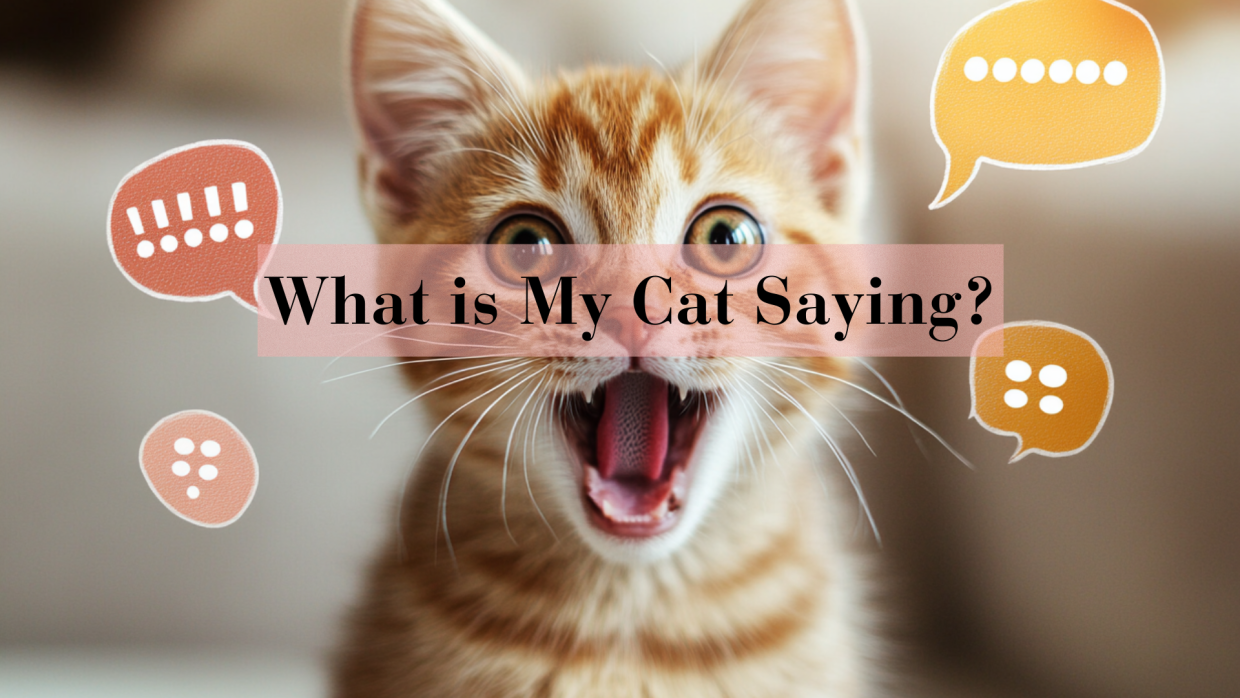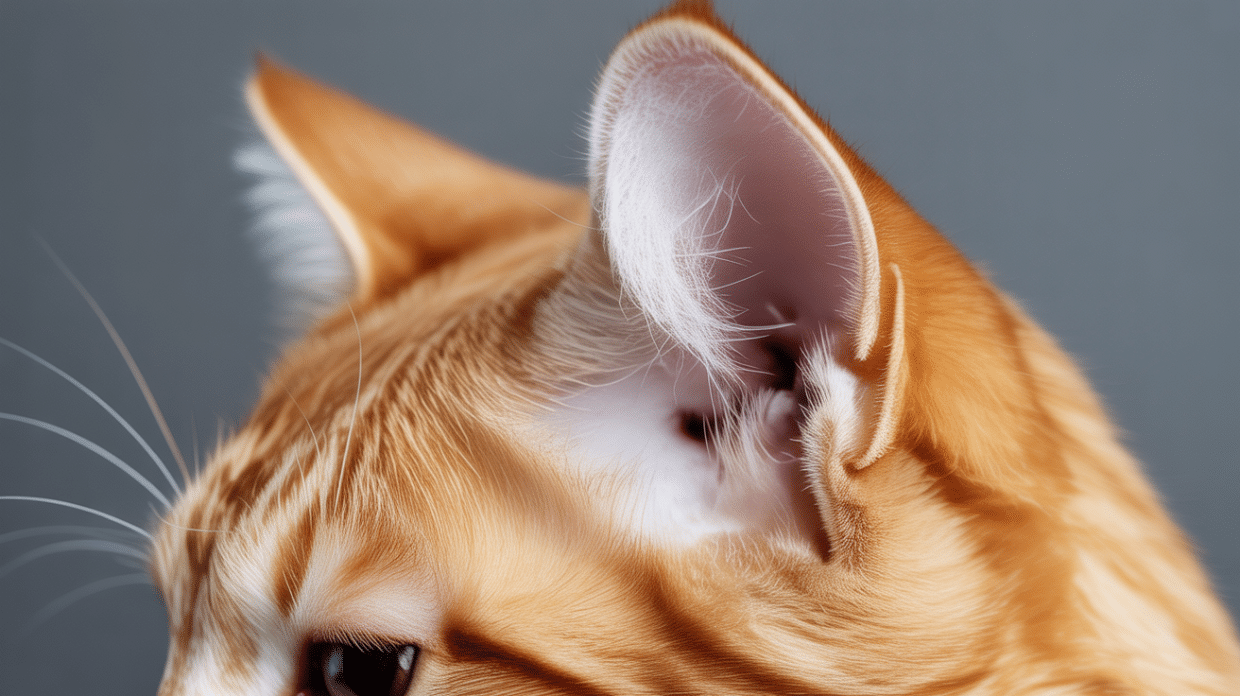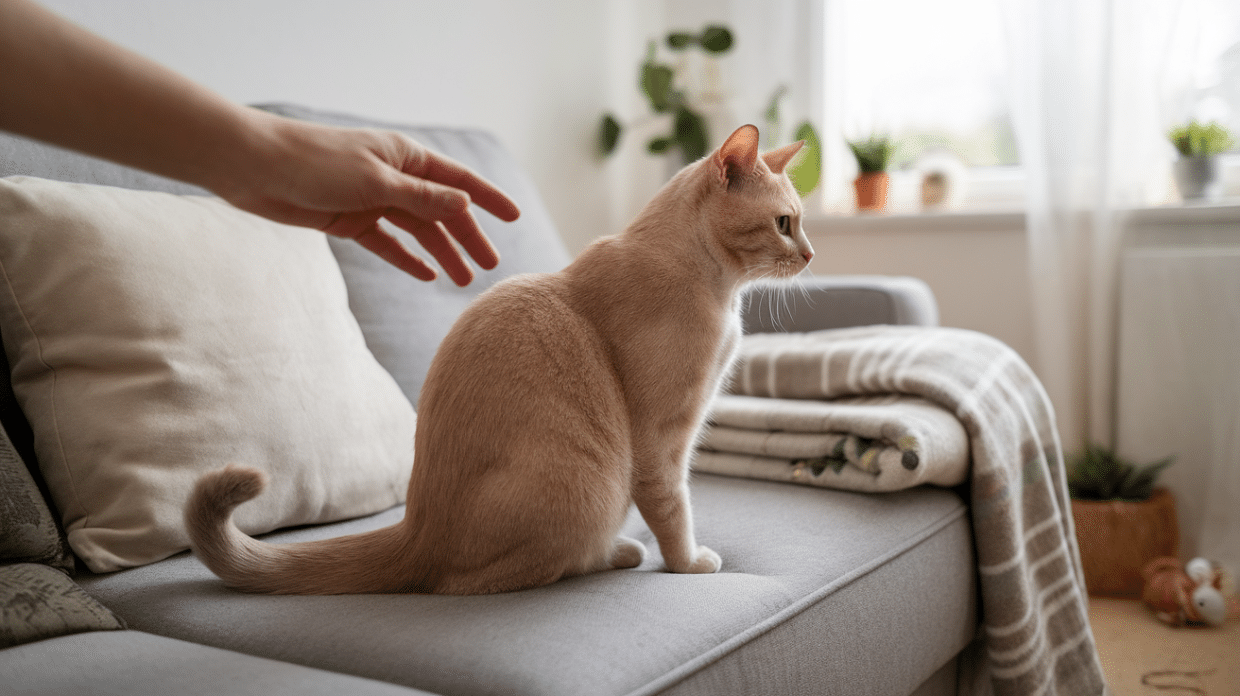When your cat makes noises, they’re trying to tell you something. Cats use sounds and body signals to share their needs, feelings, and wants with us.
The short “meow” might be a simple hello, while a longer call could mean they need food now.
What makes cat talk tricky is that the same sound can mean different things depending on when and how the cat uses it.
A purr often shows happiness, but cats sometimes purr when sick or worried.
Learning what your cat is saying helps build a better bond between you.
This guide will help you understand your cat’s language, from its various meows to its body movements.
Understanding Cat Vocalizations
Cats talk to us through different sounds.
Every noise your cat makes has meaning; learning these sounds helps you know what they need or feel.
Cats rarely meow at other cats but use these sounds to talk with people.
1. Meowing & What it Means
Cats speak to us using different types of meows. A quick, short meow is often just their way of saying hello when they see you.
If your cat lets out a long, drawn-out meow, they’re likely asking for something specific – maybe their food bowl is empty, or they want you to open a door.
The yowl is a much louder, longer meow that sounds more urgent.
This can signal that your cat is in pain, feeling very upset, or looking for a mate for outdoor cats.
2. Purring: More than Just Happiness
While we often think purring means a cat is happy, it’s more complex.
Yes, cats purr when content and relaxed, but they also purr when they’re not feeling well, anxious, or in pain.
Some experts believe cats use purring as a self-soothing method.
If your normally quiet cat suddenly purrs a lot, especially with other unusual behaviors, it might be worth a vet visit.
3. Chirping, Trilling, & Chattering
Have you noticed your cat making odd, bird-like chirps when watching birds through a window? This excited sound comes from their hunting instinct.
Trilling is a sweet, rolling sound mother cats use with their kittens to get them to follow.
When your pet makes this noise at you, they’re being friendly and might want you to come along with them.
Chattering—that odd jaw-quivering sound—typically happens when cats see prey they can’t reach.
4. Growling, Hissing & Spitting: Warning Signs
When your cat growls, they’re upset. This low, rumbling sound warns that they feel threatened and need space.
Hissing isn’t always about being mean—it’s a sign your cat feels scared or cornered.
Even the sweetest cats will hiss when they need to protect themselves.
Take it seriously if your cat makes a spitting sound (a sharp, sudden noise often accompanied by a quick head movement).
This is their final warning before they might need to defend themselves.
Non-Verbal Cues: Body Language Matters
Cats communicate in ways that are both obvious and subtle.
While we often focus on their meows, our feline friends express themselves through a complex mix of sounds, movements, and behaviors.
By understanding these signals, you can build a deeper connection with your cat and better respond to its needs.
Ears, Tail, and Eyes: What Your Cat’s Movements Say
Your cat’s body tells you much more than their voice ever could.
When ears point forward, your cat is alert and interested. Ears flat against the head mean they’re scared or upset.
The eyes also share important messages. When your cat blinks slowly at you, it’s showing trust, not sleepiness.
Cat experts call this the “cat kiss.” Try blinking slowly back to show you care.
The tail position is another key signal.
An upright tail shows confidence and happiness, a low tail suggests fear, and a puffed-up tail means your cat feels threatened.
Rubbing, Kneading, and Licking
When your cat rubs their face against you, it’s marking you with scent from special glands on their cheeks.
This gentle head bump says, “you belong to me.”
Kneading—that pushing motion with their paws—comes from kittenhood when babies knead their mother’s belly while nursing. When your cat kneads on your lap, they feels safe with you.
A cat licking you shows trust, as cats groom those they consider family.
But watch for too much self-licking in one spot, which might signal stress or a skin problem.
How to Respond to Your Cat’s Communication
Understanding what your cat is saying is only half the equation – knowing how to respond appropriately completes the conversation.
Cats are sensitive animals who notice how we react to their signals.
Your thoughtful responses can strengthen your bond, and help meet their needs effectively, making you happier in your shared home.
Should You Meow Back at Your Cat?
Talking back to your cat builds your connection, even if they don’t understand the words. Use a gentle tone – that matters more than what you say.
Watch for changes in your cat’s normal talking patterns.
A quiet cat suddenly making a noise or a chatty cat going silent might mean health problems. Older cats who yowl often may need a vet check.
Help stressed cats by creating a quiet space with items that smell like you. Keep feeding and play times regular to cut down on begging meows.
Puzzle toys keep bored cats busy, and pheromone diffusers can help anxious pets.
Can AI Help: The Rise of Cat Translation Apps
Technology now offers new ways to understand our feline friends.
Cat translation apps are a growing trend in pet tech.
How Apps Like “Meow Talk” Claim to Work
MeowTalk uses AI and sound analysis to interpret cat sounds. The app records your cat’s vocalizations.
It then compares these sounds to its database. The app claims to identify different meanings based on tone and pitch patterns.
Each cat has its own vocal style. The app attempts to learn your specific cat’s sounds over time.
Are they Accurate or Just a Novelty?
The science behind cat translation apps is still growing.
No app can perfectly translate your cat yet. They offer general hints based on common cat sounds.
Most cat experts doubt that these apps work well.
They point out that a meow’s meaning changes based on your cat’s body signals and what’s happening around them.
These apps can be fun and might help new cat owners notice their pet’s sounds more.
But nothing beats learning your own cat’s way of talking through careful watching and bonding.
Conclusion
Learning your cat’s language takes time and attention. Each cat has a unique way of talking to its humans.
Listen to their meows, purrs, and other sounds. Watch their ear positions, tail movements, and body posture.
These clues work together to tell you what your cat needs.
Trust your connection with your pet. The more you pay attention to how your cat speaks to you, the better you’ll understand them.
This knowledge builds a stronger bond between you. Your cat may not speak human words, but they have much to say!
Frequently Asked Questions
Can Cats Understand Human Words?
Cats recognize tone and routine more than actual words. They learn to associate certain sounds with outcomes like food or play.
Why do Some Cats Meow More than Others?
Some breeds, like the Siamese, talk more naturally. Individual personality, upbringing, and how much you respond to their meows affect vocal habits.
Do Cats Recognize their Name?
Yes, most cats learn their names. They may not always choose to respond, but studies show they can tell their name from other words.









